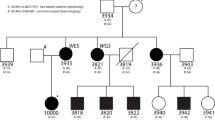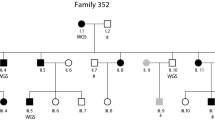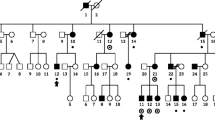Abstract
Four genes, DYX1C1, ROBO1, DCDC2 and KIAA0319 have been studied both genetically and functionally as candidate genes for developmental dyslexia, a common learning disability in children. The identification of novel genes is crucial to better understand the molecular pathways affected in dyslectic individuals. Here, we report results from a fine-mapping approach involving linkage and association analysis in Finnish and German dyslexic cohorts. We restrict a candidate region to 0.3 Mb on chromosome 7q33. This region harbours the gene diacylglycerol kinase, iota (DGKI) which contains overlapping haplotypes associated with dyslexia in both Finnish and German sample sets.


Similar content being viewed by others
References
Amet LE, Lauri SE, Hienola A, Croll SD, Lu Y, Levorse JM, Prabhakaran B, Taira T, Rauvala H, Vogt TF (2001) Enhanced hippocampal long-term potentiation in mice lacking heparin-binding growth-associated molecule. Mol Cell Neurosci 17(6):1014–1024
Anthoni H, Zucchelli M, Matsson H, Muller-Myhsok B, Fransson I, Schumacher J, Massinen S, Onkamo P, Warnke A, Griesemann H, Hoffmann P, Nopola-Hemmi J, Lyytinen H, Schulte-Korne G, Kere J, Nothen MM, Peyrard-Janvid M (2007) A locus on 2p12 containing the co-regulated MRPL19 and C2ORF3 genes is associated to dyslexia. Hum Mol Genet 16(6):667–677
Barrett JC, Fry B, Maller J, Daly MJ (2005) Haploview: analysis and visualization of LD and haplotype maps. Bioinformatics 21(2):263–265
Bates TC, Luciano M, Castles A, Coltheart M, Wright MJ, Martin NG (2007) Replication of reported linkages for dyslexia and spelling and suggestive evidence for novel regions on chromosomes 4 and 17. Eur J Hum Genet 15(2):194–203
Caylak E (2007) A review of association and linkage studies for genetical analysis of learning disorders. Am J Med Genet B Neuropsychiatr Genet 144B(7):923–943
Ding L, Traer E, McIntyre TM, Zimmerman GA, Prescott SM (1998) The cloning and characterization of a novel human diacylglycerol kinase, DGKiota. J Biol Chem 273(49):32746–32752
Gibbons AS, Scarr E, McLean C, Sundram S, Dean B (2009) Decreased muscarinic receptor binding in the frontal cortex of bipolar disorder and major depressive disorder subjects. J Affect Disord 116(3):184–191
Jagannathan K, Calhoun VD, Gelernter J, Stevens MC, Liu J, Bolognani F, Windemuth A, Ruano G, Assaf M, Pearlson GD (2010) Genetic associations of brain structural networks in schizophrenia: a preliminary study. Biol Psychiatry 68(7):657–666
Kaminen N, Hannula-Jouppi K, Kestila M, Lahermo P, Muller K, Kaaranen M, Myllyluoma B, Voutilainen A, Lyytinen H, Nopola-Hemmi J, Kere J (2003) A genome scan for developmental dyslexia confirms linkage to chromosome 2p11 and suggests a new locus on 7q32. J Med Genet 40(5):340–345
Katusic SK, Colligan RC, Barbaresi WJ, Schaid DJ, Jacobsen SJ (2001) Incidence of reading disability in a population-based birth cohort, 1976–1982, Rochester, Minn. Mayo Clinic proceedings 76(11):1081–1092
Kruglyak L, Lander ES (1998) Faster multipoint linkage analysis using Fourier transforms. J Comput Biol 5(1):1–7
Kruglyak L, Daly MJ, Reeve-Daly MP, Lander ES (1996) Parametric and nonparametric linkage analysis: a unified multipoint approach. Am J Hum Genet 58(6):1347–1363
Lai CS, Fisher SE, Hurst JA, Vargha-Khadem F, Monaco AP (2001) A forkhead-domain gene is mutated in a severe speech and language disorder. Nature 413(6855):519–523
Martin ER, Monks SA, Warren LL, Kaplan NL (2000) A test for linkage and association in general pedigrees: the pedigree disequilibrium test. Am J Hum Genet 67(1):146–154
Massinen S, Tammimies K, Tapia-Paez I, Matsson H, Hokkanen ME, Soderberg O, Landegren U, Castren E, Gustafsson JA, Treuter E, Kere J (2009) Functional interaction of DYX1C1 with estrogen receptors suggests involvement of hormonal pathways in dyslexia. Hum Mol Genet 18(15):2802–2812
Merida I, Avila-Flores A, Merino E (2008) Diacylglycerol kinases: at the hub of cell signalling. Biochem J 409(1):1–18
Nakanishi K, Tokita Y, Aono S, Ida M, Matsui F, Higashi Y, Oohira A (2010) Neuroglycan C, a brain-specific chondroitin sulfate proteoglycan, interacts with pleiotrophin, a heparin-binding growth factor. Neurochem Res 35(8):1131–1137
Petryshen TL, Pauls DL (2009) The genetics of reading disability. Curr Psychiatry Rep 11(2):149–155
Poelmans G, Buitelaar JK, Pauls DL, Franke B (2010) A theoretical molecular network for dyslexia: integrating available genetic findings. Mol Psychiatry Oct 19:1–18
Rauvala H (1989) An 18-kd heparin-binding protein of developing brain that is distinct from fibroblast growth factors. EMBO J 8(10):2933–2941
Rosen GD, Bai J, Wang Y, Fiondella CG, Threlkeld SW, LoTurco JJ, Galaburda AM (2007) Disruption of neuronal migration by RNAi of Dyx1c1 results in neocortical and hippocampal malformations. Cereb Cortex 17(11):2562–2572
Schumacher J, Anthoni H, Dahdouh F, Konig IR, Hillmer AM, Kluck N, Manthey M, Plume E, Warnke A, Remschmidt H, Hulsmann J, Cichon S, Lindgren CM, Propping P, Zucchelli M, Ziegler A, Peyrard-Janvid M, Schulte-Korne G, Nothen MM, Kere J (2006) Strong genetic evidence of DCDC2 as a susceptibility gene for dyslexia. Am J Hum Genet 78(1):52–62
Seeger T, Fedorova I, Zheng F, Miyakawa T, Koustova E, Gomeza J, Basile AS, Alzheimer C, Wess J (2004) M2 muscarinic acetylcholine receptor knock-out mice show deficits in behavioral flexibility, working memory, and hippocampal plasticity. J Neurosci 24(45):10117–10127
Shaywitz SE, Shaywitz BA, Fletcher JM, Escobar MD (1990) Prevalence of reading disability in boys and girls. Results of the connecticut longitudinal study. JAMA 264(8):998–1002
Smith SD (2007) Genes, language development, and language disorders. Ment Retard Dev Disabil Res Rev 13(1):96–105
Spielman RS, McGinnis RE, Ewens WJ (1993) Transmission test for linkage disequilibrium: the insulin gene region and insulin-dependent diabetes mellitus (IDDM). Am J Hum Genet 52(3):506–516
Topham MK, Epand RM (2009) Mammalian diacylglycerol kinases: molecular interactions and biological functions of selected isoforms. Biochim Biophys Acta 1790(6):416–424
Acknowledgments
We would like to acknowledge the families included in this report, for their participation and the MAF (Mutation Analysis Facility) core facility at Karolinska Insitutet for advice. The study was supported by the Academy of Finland, the Magnus Bergvall’s fund, the Osk. Huttunen Foundation, the Swedish Research Council, the Swedish Royal Bank Tercentennial Fund and the Karolinska Institutet (Sweden), the Finnish Center of Excellence Program (#40166 for 1997–1999, #44858 for 2000–2005 and #213486 for 2006–2011), the Niilo Mäki Foundation and the University of Jyväskylä (Finland). The Departments of Child and Adolescent Psychiatry, Psychosomatics and Psychotherapy (University of Munich, Germany) and the Department of Child and Adolescent Psychiatry, Psychosomatics and Psychotherapy (University of Wuerzburg, Germany) were supported by funds DFG-WA715/7-1 and RE 471/15-1 for this study.
Conflict of interest
The authors declare that there are no conflicts of interests.
Author information
Authors and Affiliations
Corresponding authors
Additional information
Edited by Elena Grigorenko and Brett Miller.
Electronic supplementary material
Below is the link to the electronic supplementary material.
Rights and permissions
About this article
Cite this article
Matsson, H., Tammimies, K., Zucchelli, M. et al. SNP Variations in the 7q33 Region Containing DGKI are Associated with Dyslexia in the Finnish and German Populations. Behav Genet 41, 134–140 (2011). https://doi.org/10.1007/s10519-010-9431-4
Received:
Accepted:
Published:
Issue Date:
DOI: https://doi.org/10.1007/s10519-010-9431-4




